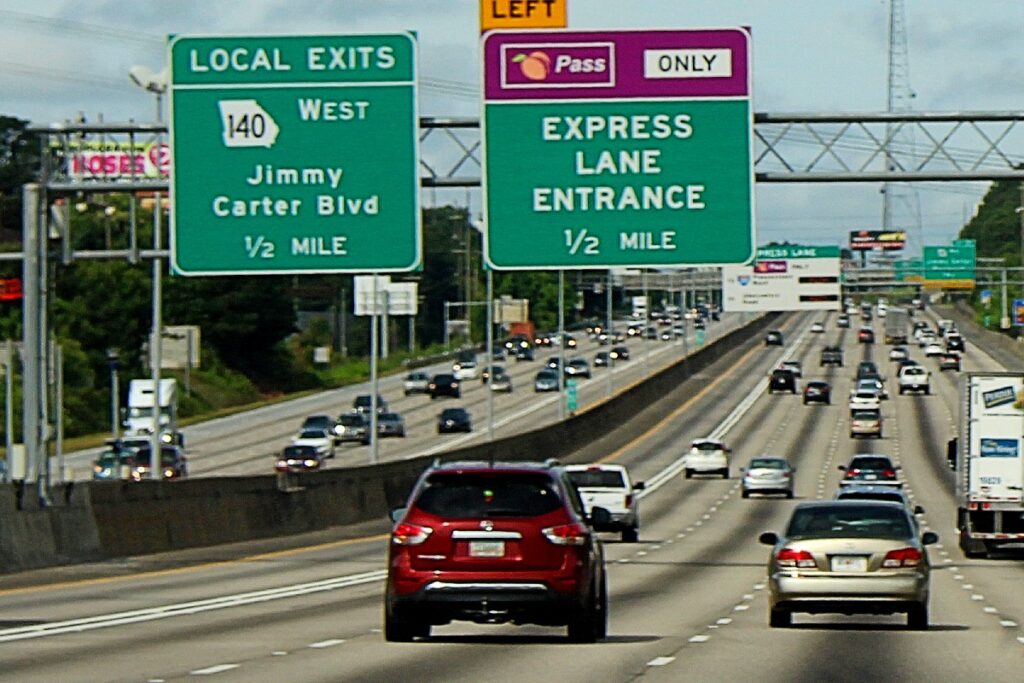By Elliott Brack
Editor and Publisher, GwinnettForum
May 26, 2023 | The idea of honoring President Carter with a road named for him in Gwinnett came from former county commissioner Ray Gunnin of Norcross. In November 1976, signs went up re-naming Norcross Tucker Road (Georgia Highway 140) as Jimmy Carter Boulevard, two months before Carter became president.
![]() What became the complete 9.1 mile-Jimmy Carter Boulevard really began in 1975 when the county built a connector from Rockbridge Road to Mountain Industrial Boulevard at U.S. Highway 29.
What became the complete 9.1 mile-Jimmy Carter Boulevard really began in 1975 when the county built a connector from Rockbridge Road to Mountain Industrial Boulevard at U.S. Highway 29.
On the western side of Jimmy Carter Boulevard, in 1981, the county extended a new four-lane road from Norcross Tucker Road in Norcross toward Buford Highway, with an underpass at the Norfolk Southern Railroad, connecting with Holcomb Bridge Road in today’s Peachtree Corners. In effect, the road from Mountain Industrial, via Jimmy Carter Boulevard and Holcomb Bridge Road, and on to Georgia Highway 400, was a parallel corridor to I-285.
What before 1952 was a dirt road had blossomed into a four-lane highway, driven largely from the development of Metro Atlanta’s first high-tech industry. That was the announcement in 1969 that the national telecommunications firm, Western Electric, would build a copper cable manufacturing plant on 175 acres in Gwinnett. It was located at the intersection of I-85 and Norcross-Tucker Road. Heralded as a $20 million plant that would employ 2,000, it eventually employed 3,800 people.
Western Electric’s groundbreaking was in October 1969, and the first production shipment of copper cable was made in 1973. Gwinnett County got its first $1 million property tax payment from a single industry, Western Electric, in 1972.
An integral part of the Western Electric facility in Norcross was its research arm, Bell Labs. I was part of the media in 1976 that Bell Labs invited to an announcement of a dramatic change in communications. That day Bell Labs introduced what they called initially “Light guides,” that is, tiny hair-sized fibers that carried light, which was patented out of Bell Labs in Norcross. Engineers told us that “light guides,” today known as “fiber optics,” would revolutionize the world, and eventually take the place of copper cable.
In the 1970, the arrival of Western Electric also started a housing boom in Gwinnett, first seen near Atlanta in the Norcross to Lilburn area. Since then, that housing boom has never stopped in Gwinnett.
Georgia Tech graduate Paul Duke had an idea in 1970 to build a community where people could live, work and play, and would employ Georgia Tech graduates in engineering jobs. That was the start of Technology Park/Atlanta, which opened in 1972. It became a hotbed of excellent jobs in high tech fields. If you were in those days in high tech, you had a Norcross address.
 A key factor in Gwinnett high-tech positioning in the 1980s came via Hayes Microcomputer. Those behind this company, Dennis Hayes and Dale Hearthington, invented a way to allow computers to talk to one another through their modem. This sat the high-tech world on its ear, with Gwinnett at its center. Today those working on computers never realize that modems are built into their units to allow accessibility to the Internet.
A key factor in Gwinnett high-tech positioning in the 1980s came via Hayes Microcomputer. Those behind this company, Dennis Hayes and Dale Hearthington, invented a way to allow computers to talk to one another through their modem. This sat the high-tech world on its ear, with Gwinnett at its center. Today those working on computers never realize that modems are built into their units to allow accessibility to the Internet.
Key to today’s Jimmy Carter Boulevard changes has been Gwinnett Village CID, beginning in 2006, now called Gateway85 CID. It has dramatically improved the Jimmy Carter Boulevard corridor. What was once a deteriorating neighborhood has bounced dramatically back, and now includes 3,000 businesses which employ 47,000 people. Today there are six CIDs in Gwinnett, with Gateway85 being the county’s largest CID, covering 14 square miles.
The mover behind this week’s tribute to Jimmy Carter is the executive director of the Gateway85 CID, Emory Morsberger. We all owe Emory our thanks for this incredible idea to honor our former president.
- Have a comment? Send to: elliott@brack.net










Follow Us